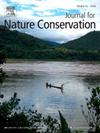基于生态位模型的濒危洪蛙新种群及其他可能的适宜地点
IF 2.5
3区 环境科学与生态学
Q2 BIODIVERSITY CONSERVATION
引用次数: 0
摘要
大西洋森林是巴西退化最严重的生物群落之一,这使它成为全球生物多样性的热点。水蛙属是该地区特有的物种,其中8种在一定程度上面临灭绝的威胁。作为一种濒危物种,海蛞蝓正面临着保护方面的挑战,从其有限栖息地的破坏到全球气候变化。本研究采用系统发育分析和生态位建模方法,对新发现的种群及其空间分布进行了分析,并对其保护现状进行了重新评估。系统发育分析结果显示,该新种群具有较强的支撑力,生态位模拟结果令人满意,突出了该物种的适宜区。然而,即使有了这个新发现的地点,在国家和州一级评估中的威胁类别也没有改变,因为在几乎所有已知的种群中,它们的发生范围仍然很小,而且对其保护的威胁过多。我们建议对国际水平的评估进行更新,以更好地反映该物种目前的保护状况。最后,我们主张在整个物种分布范围内保护水体和河岸森林。此外,我们鼓励在森林地区寻找新的出现区域,这些区域的水体集中在模型所带来的适合该物种的区域,并提倡使用系统发育分析来准确区分属内的相似物种。本文章由计算机程序翻译,如有差异,请以英文原文为准。
A new population of the threatened torrent-frog Hylodes sazimai and other possible suitable sites based on ecological niche modeling
The Atlantic Forest is one of the most degraded biomes in Brazil and that makes it a global biodiversity hotspot. The torrent-frog genus Hylodes is endemic to this region and eight of its species are threatened with extinction to some degree. Hylodes sazimai, one of the threatened species, is facing conservation challenges that range from destruction of its restricted habitat to global climate changes. In this study, we used phylogenetic analyses and ecological niche modeling approaches to assess a newly discovered population, the spatial distribution of this species, and reassess its conservation status. The phylogenetic analyses recovered the new population within H. sazimai with strong support and the ecological niche modeling had a satisfactory performance, highlighting suitable areas for the species. However, even with this newly found location the threat category in the national and state level assessment did not change, due to the still small extension of occurrence and plethora of threats to its conservation in nearly all known populations. We recommend an update to the international level assessment to better reflect the current conservation state of the species. Finally, we advocate for the preservation of water bodies and riparian forests throughout the species range of distribution. Furthermore, we encourage the search for new areas of occurrence in forested areas that have water bodies focusing on the areas brought by the modeling as suitable for the species and advocate for the use of phylogenetic analysis to accurately distinguish between the similar species within the genus.
求助全文
通过发布文献求助,成功后即可免费获取论文全文。
去求助
来源期刊

Journal for Nature Conservation
环境科学-生态学
CiteScore
3.70
自引率
5.00%
发文量
151
审稿时长
7.9 weeks
期刊介绍:
The Journal for Nature Conservation addresses concepts, methods and techniques for nature conservation. This international and interdisciplinary journal encourages collaboration between scientists and practitioners, including the integration of biodiversity issues with social and economic concepts. Therefore, conceptual, technical and methodological papers, as well as reviews, research papers, and short communications are welcomed from a wide range of disciplines, including theoretical ecology, landscape ecology, restoration ecology, ecological modelling, and others, provided that there is a clear connection and immediate relevance to nature conservation.
Manuscripts without any immediate conservation context, such as inventories, distribution modelling, genetic studies, animal behaviour, plant physiology, will not be considered for this journal; though such data may be useful for conservationists and managers in the future, this is outside of the current scope of the journal.
 求助内容:
求助内容: 应助结果提醒方式:
应助结果提醒方式:


